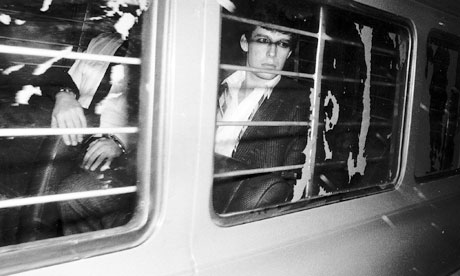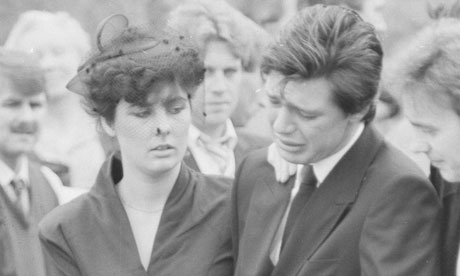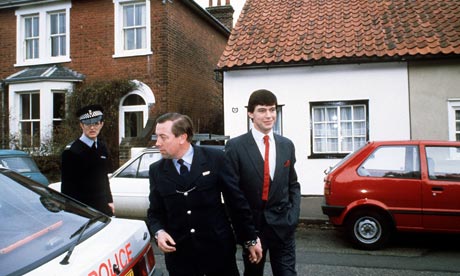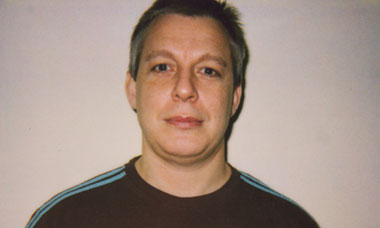"I'll be able to relax on a Dorset beach and watch the waves crashing, walking, hearing the birds sing, and hopefully have someone around me, or people around me, who I love and they love me. Just simple things."
Jeremy Bamber

 Bamber in tears at his family's funeral in 1985, supported by his then girlfriend Julie Mugford. Photograph: Peter Davies/McLellan
Bamber in tears at his family's funeral in 1985, supported by his then girlfriend Julie Mugford. Photograph: Peter Davies/McLellan
 Jeremy Bamber in 1988, just before the first appeal against his conviction. Photograph: Today/Rex Features
Jeremy Bamber in 1988, just before the first appeal against his conviction. Photograph: Today/Rex Features
 Bamber in a picture taken in prison, 2009. Photograph: Guardian
Bamber in a picture taken in prison, 2009. Photograph: Guardian
Jeremy Bamber

Jeremy Bamber is driven to prison in 1986 after being convicted of killing his mother, father, sister and her twin sons. Photograph: Trinity Mirror/Mirrorpix/Alamy
Jeremy Bamber is thinking about how he has maintained his sanity over 25 years in prison. His answer is quietly shocking. He walks and talks with his family – his mother, his sister, her twin sons and particularly his father. In short, he gets solace from the memory of the very family he was convicted of slaying 26 years ago. "In my mind, I walk with my Dad more than anybody on a daily basis and think, how would he cope with it, what would he think about it all?" He comes to a stuttering stop. You can hear the pain in his voice. "How I cope is quite an emotional thing for me to talk about."
Jeremy Bamber is one of only 38 prisoners in England and Wales serving a whole-life sentence, and the only one of them to protest his innocence. The list is as chilling as it is exclusive – Bamber is in the company of Rose West, Dennis Nilsen, Peter Sutcliffe and Ian Brady. The judge at his trial described him as "warped and evil beyond belief". If he committed the crimes he has been convicted of, he deserves his notoriety.
Yet Jeremy Bamber has always protested his innocence. The Guardian has corresponded with him over five years, during which time dozens of letters have been exchanged. His are written in block capitals, breathless in their intensity, polite, largely impersonal and almost wholly concerned with the evidence. They are not a light read. He expects those interested in his case to be as well drilled in the minutiae as he is. If Jeremy Bamber is telling the truth, he is a victim of one of Britain's worst miscarriages of justice.
To decipher the letters one has to learn the courtroom shorthand – DRB1, a reference to the "sound moderator", or silencer. PV19? A bullet fragment. RWC1, the paint sample taken from the kitchen, where Nevill Bamber was killed. And so it goes on, with references to the thousands of exhibits, documents and photographs.
Jeremy Bamber is clever and strategic. He has courted a number of news organisations over the years. He divides the evidence he has gathered and packages "exclusives" to different newspapers. The Guardian has made repeated requests to interview him, but has always been blocked by the Ministry of Justice. So it was a surprise when a member of staff at Full Sutton prison, near York, asked whether we were willing to accept phone calls from Jeremy Bamber, AKA prisoner A5352AC.
It was late January when he rang, just before he was due to hear from the Criminal Cases Review Commission whether his case would be referred for a rare third appeal. He said he had saved money so he could afford half an hour on the phone. This Jeremy Bamber sounded quite different from the letter writer – talkative, human, dealing in emotions. We didn't need to deal with all his new information – he had already painstakingly laid out how he had recently discovered evidence that suggested the crime scene had been used for training purposes by more than 40 officers from the firearms support unit just hours after the murders, which may have corrupted evidence; how bodies seem to have been moved; how freshly disclosed Essex police files appeared to challenge the assertion that Jeremy Bamber was the killer.
On 7 August 1985, Jeremy's mother, father, sister and her six-year-old boys were shot dead at the parents' farmhouse in the Essex countryside. It was a sensational story, a classic whodunit – a whole family murdered, a substantial inheritance to be fought over, complex relationships with adopted children, and a glamorous model known as Bambi at the heart of it.
 Bamber in tears at his family's funeral in 1985, supported by his then girlfriend Julie Mugford. Photograph: Peter Davies/McLellan
Bamber in tears at his family's funeral in 1985, supported by his then girlfriend Julie Mugford. Photograph: Peter Davies/McLellan
That night, Jeremy Bamber rang the police saying he had just received a panicked call from his father Nevill saying his daughter Sheila had picked up one of his shooting rifles and had gone "crazy". By the time the police entered the house, all five were dead. The gun was found by Sheila's side, fresh blood still oozing from her mouth. It looked as if she had killed her mother and father and her twin boys before turning the gun on herself. It all seemed to make sense in a terrible way – a woman who had recently been diagnosed with schizophrenia had broken down. But then the story took an unexpected turn. Jeremy's girlfriend, Julie Mugford, whom he had two-timed, claimed he had confessed to her his plans to hire a hitman to murder the family and that hours before the shooting he had told her: "Tonight's the night." The man named was a local plumber, who was arrested with Jeremy. The plumber had a cast-iron alibi for that night and both were released.
A month after the killings, Jeremy's cousins found a silencer with flecks of blood on it in a cupboard in the farmhouse – this would have ruled out Sheila being the killer because, with the silencer on the rifle, her arms would not have been long enough to reach the trigger to kill herself, and it left Jeremy Bamber as the only suspect. Jeremy was charged and the prosecution argued he was a greedy schemer who, motivated by the prospect of inheriting the £436,000 family fortune and considerable land, had killed all five then placed the rifle in his sister's hands to make it look like a murder-suicide. He was found guilty in a 10-2 majority verdict and given five life sentences, upgraded to whole life in 1994.
There was something about Jeremy Bamber that made him unsympathetic to the public. He was handsome in a rather cruel, caddish way – he seemed to exude arrogance and indifference. In court, when the prosecution accused him of lying, he replied: "That is what you have to establish." Like Meursault in the Camus novel L'Etranger, he did not seem to display the appropriate emotions. Or at least not when the press had its lens fixed on him. More tales emerged about his callousness – how he had spent money with abandon after his parents' death, how he was living the life of a playboy. And then there was his sister, the other suspect – Sheila (known as Bambi) was so blessed with her beauty, so vulnerable with her illness, few people wanted to believe she could have been the killer.
 Jeremy Bamber in 1988, just before the first appeal against his conviction. Photograph: Today/Rex Features
Jeremy Bamber in 1988, just before the first appeal against his conviction. Photograph: Today/Rex Features
So Jeremy Bamber went to jail, and ever since he has told anyone who would listen that he is innocent. He sieved his way through myriad documents, trying to piece together another version of what could have happened that night at White House Farm. He became a legal expert, stayed up into the early hours every night reading his own case notes, he courted sympathetic journalists, wrote to legal experts, challenged the very basis on which he had been convicted.
And gradually it emerged that the investigation had been, at best, flawed: the police had not searched the farmhouse properly; a call from Jeremy's father to the police, saying his daughter had gone "berserk", had not been disclosed to the jury; officers had said they had seen somebody moving inside the house before they entered while Jeremy was standing next to them. How had the police failed to find a silencer in the cupboard? Why was it not revealed that the people who did find it – the cousins – stood to benefit from Bamber going to jail by inheriting the property. Why had so many people been allowed to trudge through the crime scene, contaminating so much of the evidence? Why did scratch marks on the kitchen mantelpiece that suggested a struggle not exist in the original scene-of- crime photos?
The new evidence on the marks is perhaps the most compelling. The trial judge, in his summing up, told the jury: "On the evidence of the scratch marks alone you may find Mr Bamber guilty." But the photographs they were shown were taken after the silencer was discovered. Photographs taken on the day of the shootings and not disclosed at trial have emerged showing there were no scratch marks, which contradicts the evidence of a struggle – a completely different picture to the one presented to the jury.
Jeremy Bamber appealed for the first time in 1989 on the grounds that the judge had summed the case up unfairly. He was finally granted a second appeal in 2002. Jeremy's team argued that vital evidence had not been disclosed or had been fabricated, most of it relating to the silencer and the blood testing. The silencer was found to contain blood, but it could not be established if it was human or animal. But in a 522-point judgment, the three judges concluded that no conduct on behalf of the police or the prosecution would have adversely affected the jury, and that the more they examined the details, the more they thought the jury had reached the right conclusion.
When he lost that appeal, Jeremy says, it was "as if the light had gone out". How did he feel? "Desolate. I felt abandoned. It was just before Christmas that they gave me that decision and I remember that Christmas Day I had jam and toast because I'd not put in menu slips for my dinner." He had expected to be home for Christmas. "I felt I was the laughing stock of the jail in that I had told people I was going to win and I didn't. I felt friendless."
His case should be referred back to the appeal court imminently. And Jeremy Bamber is convinced that, this time, his conviction has to be overturned. "I shall feel hope again. I shall feel that maybe, finally, my position, which I've held for 26 years, will be validated."
Jeremy Bamber was 24 when he was convicted, and has been in prison more than half his life. He is fit, but he is only too aware of life passing him by. "I'm an old man now. I'm 50 and I feel it," he says. If this is a miscarriage of justice, it is the worst kind of double whammy – not simply convicted of murder, but of murdering those you love. Has he managed to grieve for the family he is convicted of killing? "I think what helped is that I was out for their funerals. It wasn't until almost two months later that I was arrested, so I have grieved to some degree, but I'm not sure I have grieved enough. But I cope . . . I just have happy memories."
If he is cleared, he says, he will feel he has defended the family's honour. "I will feel proud that if Mum and Dad were around, they would be proud that I had the self-discipline and staying power to keep with this as long as I have." And this is when you realise just how complex his relationship is with his family. In finding him guilty of the massacre, he believes the court besmirched his family name. If his sister is guilty, it does not in any way lessen the horror, but it is less shaming because she was ill.
Nevill and June Bamber adopted Jeremy when he was six weeks old. He was the son of a vicar's daughter who had an affair with a married army sergeant. (His sister Sheila was adopted a few years later.) He was sent to a private boarding school in Norfolk, then went to college in Colchester and, after spending time in Australia and New Zealand, he returned to work on the farm for £170 a week. At the time of the murders, he lived in a cottage owned by his father three miles away from the family farm.
What was life like on the farm? "Idyllic," he says. "It can be quite a solitary life, but I am a person who's quite happy with my own company. Mum and Dad were wonderful people, very kind, very gentle, very honest people. I loved them with all my heart and they were my mum and dad. I resent the 'adopted child', because I never saw myself as an adopted child."
If he is lying, he is a disturbingly good actor. Five years ago, he took and passed a lie-detector test. He has seen numerous therapists and psychiatrists in his time in prison, none of whom has suggested that he is mentally unstable, let alone a psychopath.
He says he and Sheila were close when they were growing up. "She looked after me, she cared for me and when I was 14/15 and she was modelling, I loved going up to London, staying with her and going out with all her modelling mates."
But ultimately, he says, when she became ill they weren't close enough. "Schizophrenia, especially if it's coupled with paranoia, can be the most devastating illness. I certainly take my share of the blame for not supporting her. And I wish I had visited her when she was in hospital. I was growing up and starting relationships and building a life for myself and I probably didn't listen and care and learn enough about Sheila's condition and give her the support I should have done. Had I done, maybe she would have been able to cope with the world – I don't know."
Sheila married at 20 in 1977, sons Daniel and Nicholas were born two years later, and by 1982 she was divorced. In 1983, suicidal and paranoid, she was hospitalised and put on anti-psychotic drugs. In March 1985, she was readmitted – delusional, obsessed with the nature of good and evil and admitting to disturbed ideas about her mother. (June Bamber had also suffered a mental breakdown when Jeremy was in his late teens – her illness, coupled with her religious fervour, created a rift between mother and adopted daughter). Again, Sheila was put on anti-psychotic drugs. Four months later, she was dead.
Her Bible was found by her side, open at pages containing Psalms 51-55. Eminent theologian Susan Gillingham has prepared a report on the significance of these psalms, in relation to Sheila's mental state and religious mania. She says anyone who knew the psalms well would turn to them as a means of "expressing their own penitence at the evil within themselves and outrage at the evil words and actions performed against them by others". Astonishingly, the bloodstained Bible was never forensically examined, nor produced at trial, despite repeated requests from Jeremy Bamber's solicitor. So the jury was not aware of the significance of the psalms. Photographs also showed a handwritten note sticking up from between the pages of the Bible. The words at the top of the note are "love one another" – the same words were written on a banner on a wall in a room in Jonestown, Guyana, where 909 people died in 1978 in a mass murder-suicide. But the evidential value of what was inside the Bible cannot now be gauged; Essex police have informed Jeremy Bamber's lawyers that the note has been destroyed.
 Bamber in a picture taken in prison, 2009. Photograph: Guardian
Bamber in a picture taken in prison, 2009. Photograph: Guardian
Hugh Ferguson, Sheila's psychiatrist, gave evidence at the trial. In a statement made in 2002, he says he was unaware that the Bible was open at the psalms at the time he gave evidence. Having read them, he says, "they contain in them the themes which, over time, I knew were exercising Sheila Caffell. In short form, the struggle between good and evil, or God and the Devil."
Nor was Ferguson, or the jury, aware of another factor that may have influenced Sheila to carry out the killings. At the trial, Bamber said his sister was upset at the prospect of losing her children, but the prosecution accused him of making this up.
Last week, the Guardian was passed a letter, written by Sheila's ex-husband, Colin Caffell, to Nevill Bamber. In it, Caffell expresses deep concern about Sheila's mental state and asks his father-in law-to "try and convince Sheila that it would be better for her and the boys if they stayed with me most of the time". Ferguson says if Nevill had pleaded Caffell's case to Sheila, it could have had a "potentially catastrophic effect on her". As a result, he says, "she may have projected on to her father a concept of evil".
How does Jeremy Bamber feel about his sister today? "I don't blame her, and I still love her." For somebody who protests his innocence so vehemently, he shows a remarkable lack of bitterness. "Oh, I have been terrible, but I don't feel it now. That just eats you up, fills you full of hate, gives you ulcers and lines around your eyes and you look horrible. I have resented Sheila and hated her over the years, but I don't any more. I understand."
One of the things that seemed to sway public opinion against Jeremy Bamber was a photograph of him smiling outside the court, apparently without a worry in the world. "I was smiling because my mates were on the pavement and they were all cheering me on. And I was giving them that encouraging smile, 'I'm OK, lads, don't worry.' I understand a picture tells a thousand stories, but we all know the media can snap that split second and not put it in context." It's one of the things that seems to upset him most – the idea that he is universally reviled.
When he was first convicted, he was convinced he would be out in no time. Nine years later, he was told that he would never be released. How did that feel? He stammers his way towards an answer. "I . . . I . . . just found that incredible that they could hand you a death sentence using old age as the tool when I'd already been sentenced to 25 years in jail." Even then, he says, he never believed he would be in jail for good. "I have never contemplated the thought that I'm not going to win."
But there is, of course, every chance that Jeremy Bamber won't win – there is a small possibility that he will not win the right to his third appeal, and the greater possibility that the conviction will be upheld at appeal. Well, if that happens, he says, he'll just have to continue fighting. He claims he's holding back some new evidence just in case he needs to fight for another appeal.
And if he is released? "I'll be able to relax on a Dorset beach and watch the waves crashing, walking, hearing the birds sing, and hopefully have someone around me, or people around me, who I love and they love me. Just simple things." He would like to write a book on motivational techniques – to help people to cope, not just in prison but with illness and bereavement.
All this is a long way from the playboy image. "I've never been a playboy," he says quietly. "I've only been to a few nightclubs in my life. I've only had a few girlfriends in my life."
There is a classic image of people who have had their convictions quashed – say, the Guildford Four or Birmingham Six – standing on the steps of the court of appeal, triumphant. Does Jeremy Bamber ever imagine himself in that pose? "Absolutely," he says. "I've got a drawing that a friend did for me of me standing on the steps with my hands raised. It's on my wall, and I look at it all the time and visualise the day."
No comments:
Post a Comment